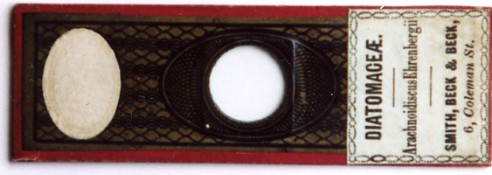
|
A Selection of Victorian Papered Microscope Slides
by Barry B. Miller, New Jersey, U.S.A. |
Victorian slide preparers took great pride and care in their work. That care is evidenced by the great many slides that have survived in highly usable condition to this day. Often, the mountant is so clear and free of discoloration or deterioration that it's amazing to think that they were made one-hundred or more years ago.
Sometimes Victorian slide preparers covered their slides with decorative papers which, on occasion, contained their name or monogram. There was a purpose to the use of paper with the early slides, as they helped to attach the cover glass to dry mounts. Even when the introduction of Canada Balsam made them unnecessary, their use continued (Bracegirdle, 1998 , p.74). The papers became a means of identification and individuality for the preparers.
Certain papers and their designs and monograms became associated with various persons. Below, are photographs of a selection of such slides. They all are covered with decorative papers and sometimes those papers contain the preparer's personal monogram. Occasionally, a secondary label is attached and when that label includes an address, it provides clues to the date in which that slide was made and sold.
As described by Thomas Davies in 1874:
“A novice would naturally think the appearance of some of the slides
above mentioned very slovenly and unfinished; but they are often covered
with ornamental papers, which may be procured at almost every
optician's, at a cost little more than nominal, and of innumerable patterns
and colours” (Thomas Davies, p. 32).
Below is a selection of photographs of paper-covered slides. A few notes are included below each photograph.

This slide is interesting due to its secondary label. The address listed for Ross (164 New Bond Street, London) dates it to 1879-1880. Ross, of course, is notable for the fine microscopes that the firm manufactured. They attached their secondary labels to slides that they sold.

An attractive preparation by William Ford Stanley, who sold slides with his attached secondary label. He lived from 1828-1909.

Fleas were common Victorian slide subjects. This attractive slide contains the secondary label of Newton and Co. That firm was located at 3 Fleet Street, London, from 1858-circa 1915.

Parasites were a common subject matter of Victorian slides. The slide of a hog parasite looks impressive through the microscope. Also impressive is the gold and black paper wrapping. The oval label on the lower portion of the slide covers the initials “JB”, which barely shows through when examining the actual slide. (It does not show up in the photograph.) JB is the identifying monogram for J. Burgess.

This slide of Sections of Clematis is by one of the most famous of all Victorian slide preparers, Charles Morgan Topping. He prepared slides with various papers, such as this green-colored monogrammed version.

Perhaps the most widely known of Charles Morgan Topping's slides are the decorated red papers that bear his name. This one is a test slide of Navicula hippocampus.

An arranged slide of the diatom Arachnoidiscus ehrenbergii. The address of “6, Coleman St.” noted on the label for the firm of Smith, Beck & Beck corresponds to the years 1857-1865.

A slide by Jh. Bourgogne. The Bourgogne family of Paris prepared many surviving slides.

These last two slides have the initials “EW”, indicating that they are by Edmund Wheeler. (The initials are difficult to see in the photographs). The beautifully handwritten labels indicate that the slides are for polariscope viewing, which reveals a range of colors.

It is my hope that this short article will inspire other Micscape readers to submit descriptions and photographs of their old slides.
I am grateful to my wife, Marcia, for reviewing the draft and making helpful suggestions.
Email comments to Barry Miller are welcomed.
References:
Bracegirdle. Brian, 1998, Quekett Microscopical Club, Microscopical Mounts and Mounters.
Bracegirdle, Brian, 1996, Quekett Microscopical Club, Notes on Modern Microscope Manufacturers.
Davies, Thomas, 1874, The Preparation & Mounting of Microscopic Objects, Second Edition.
Girodet, Pierre, 2000, Mounters, collectors and sellers of microscopical mounts in France in the 19th and 20th centuries, Quekett Journal of Microscopy, 38, pp. 573-592.
Please report any Web
problems or offer general comments to the
Micscape
Editor,
via the contact on
current Micscape Index.
Micscape is the
on-line monthly magazine of the Microscopy UK
web
site at
Microscopy-UK